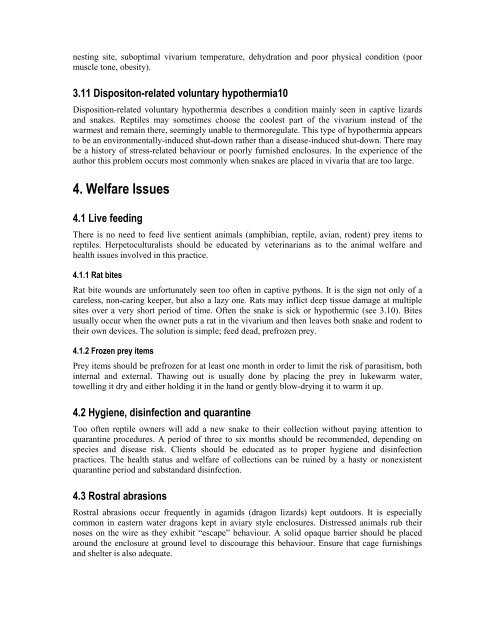Handling and Nursing Reptiles - Australian Veterinary Association
Handling and Nursing Reptiles - Australian Veterinary Association
Handling and Nursing Reptiles - Australian Veterinary Association
You also want an ePaper? Increase the reach of your titles
YUMPU automatically turns print PDFs into web optimized ePapers that Google loves.
nesting site, suboptimal vivarium temperature, dehydration <strong>and</strong> poor physical condition (poor<br />
muscle tone, obesity).<br />
3.11 Dispositon-related voluntary hypothermia10<br />
Disposition-related voluntary hypothermia describes a condition mainly seen in captive lizards<br />
<strong>and</strong> snakes. <strong>Reptiles</strong> may sometimes choose the coolest part of the vivarium instead of the<br />
warmest <strong>and</strong> remain there, seemingly unable to thermoregulate. This type of hypothermia appears<br />
to be an environmentally-induced shut-down rather than a disease-induced shut-down. There may<br />
be a history of stress-related behaviour or poorly furnished enclosures. In the experience of the<br />
author this problem occurs most commonly when snakes are placed in vivaria that are too large.<br />
4. Welfare Issues<br />
4.1 Live feeding<br />
There is no need to feed live sentient animals (amphibian, reptile, avian, rodent) prey items to<br />
reptiles. Herpetoculturalists should be educated by veterinarians as to the animal welfare <strong>and</strong><br />
health issues involved in this practice.<br />
4.1.1 Rat bites<br />
Rat bite wounds are unfortunately seen too often in captive pythons. It is the sign not only of a<br />
careless, non-caring keeper, but also a lazy one. Rats may inflict deep tissue damage at multiple<br />
sites over a very short period of time. Often the snake is sick or hypothermic (see 3.10). Bites<br />
usually occur when the owner puts a rat in the vivarium <strong>and</strong> then leaves both snake <strong>and</strong> rodent to<br />
their own devices. The solution is simple; feed dead, prefrozen prey.<br />
4.1.2 Frozen prey items<br />
Prey items should be prefrozen for at least one month in order to limit the risk of parasitism, both<br />
internal <strong>and</strong> external. Thawing out is usually done by placing the prey in lukewarm water,<br />
towelling it dry <strong>and</strong> either holding it in the h<strong>and</strong> or gently blow-drying it to warm it up.<br />
4.2 Hygiene, disinfection <strong>and</strong> quarantine<br />
Too often reptile owners will add a new snake to their collection without paying attention to<br />
quarantine procedures. A period of three to six months should be recommended, depending on<br />
species <strong>and</strong> disease risk. Clients should be educated as to proper hygiene <strong>and</strong> disinfection<br />
practices. The health status <strong>and</strong> welfare of collections can be ruined by a hasty or nonexistent<br />
quarantine period <strong>and</strong> subst<strong>and</strong>ard disinfection.<br />
4.3 Rostral abrasions<br />
Rostral abrasions occur frequently in agamids (dragon lizards) kept outdoors. It is especially<br />
common in eastern water dragons kept in aviary style enclosures. Distressed animals rub their<br />
noses on the wire as they exhibit “escape” behaviour. A solid opaque barrier should be placed<br />
around the enclosure at ground level to discourage this behaviour. Ensure that cage furnishings<br />
<strong>and</strong> shelter is also adequate.

















